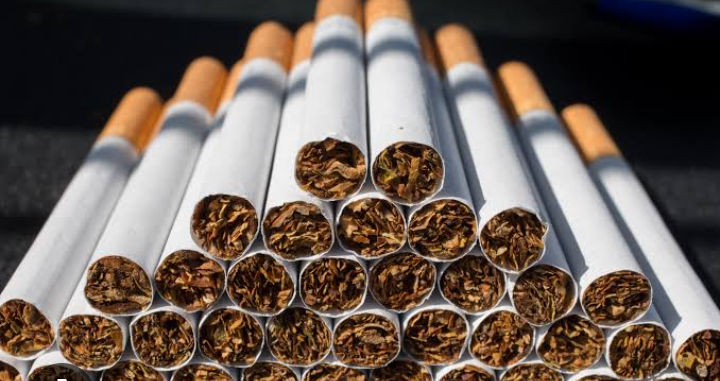
Tobacco is the only product in the world that kills half of its users.
Tobacco use kills nearly 6 million people every year, 600 000 of whom were exposed to second-hand smoke. Every 6 seconds someone dies from tobacco.
Half of current tobacco users will eventually die from a disease associated with its use. Deaths related to tobacco are expected to rise to 7.5 million by 2020, which will account for 10% of deaths worldwide.
However, if current trends continue, tobacco will kill nearly 8 million people every year throughout the period leading to 2030. Most tobacco-related deaths occur in low- and middle-income countries. Unless counter measures are taken, tobacco will kill more than 1 billion people in the 21st century.
Advocates and tobacco control groups have criticized players of the tobacco industry for their intervention in preventing effective control globally and their role in undermining the global tobacco treaty, as well as neglect for public health in the place of profits.
Members of the Network for Accountability of Tobacco Transnationals (NATT) expressed the concern at a virtual media workshop ahead of the 10th Conference of the Parties (COP10) to the World Health Organisation Framework Convention on Tobacco Control (WHO-FCTC) and the Protocol to Eliminate Illicit Trade in Tobacco Products (MOP3), holding in Panama from November 20-25 and November 27-30 respectively.
They discussed the key issues and high stakes of the upcoming meetings, being the first in-person treaty summits in five years and submitted that governments, institutions, the WHO and civil society groups must deploy everything within their reach to stop the tobacco industry from achieving its goals in the interest of public health. Legal Officer, World Health Organisation Framework Convention on Tobacco Control (WHO-FCTC), Sabina Timco Lacazzi, explained that the world loses over 8 million lives to tobacco use and exposure, adding that 183 Parties representing more than 90 percent of the world’s population observe the treaty, which came into force in 2005.
Deputy Campaigns Director of Corporate Accountability (USA), Keltie Vance, who spoke on what the NATT stands for, disclosed that several leaders of the group will attend the tobacco treaty talks in Panama, adding that Article 5.3 of the treaty addresses conflicts of interests and industry interference.
At the 8th meeting of the WHO FCTC, a decision was reached on “maximising transparency,” which asks Parties, media and civil society delegates to submit declarations of conflicts of interest. COP10 is the first in-person meeting during which this decision will be in effect.
“Article 19 of the treaty addresses liability and states that Parties will provide one another with assistance in legal proceedings relating to civil and criminal liability against the tobacco industry.
“Experience shows that implementation of Article 19 can recover health care and environmental costs incurred by governments for tobacco-related harms to people, create public climate and political will to pass and enforce the lifesaving measures enshrined in the FCTC, as well as expose and halt misconduct, deter future misconduct and punish wrongdoing.”
She added that Brazil, South Korea, Canada and the United States have initiated liability against the tobacco industry to date.
In his presentation, Executive Director, Consumer Information Network (Kenya), Samuel Ochieng, said the agenda for the COP for Africa includes Article 9 of the FCTC, which deals with contents and emissions of tobacco products.
He explained that Article 10 focuses on disclosure of tobacco products information to government authorities and the public, Tobacco Advertising, Promotion and Sponsorship (TAPS) with focus on entertainment media, as well as novel and emerging products.
He pointed out that participants looked forward to discussing matters of environmental pollution, including plastic cigarette butt pollution from the tobacco industry and tobacco products.
“So everyone must remain vigilant about sources. Tobacco industry is pushing ‘harm reduction products,’ but there is no supporting evidence that these are safer,” he stressed.
Executive Director, Vision for Alternative Development (Ghana), Labram Musah, whose presentation highlighted the African Tobacco Industry Interference Index Report 2023, said the report was created to address the urgent need for monitoring and evaluation of tobacco industry tactics, ensuring transparency in the decision-making process, raising awareness, empowering policymakers, and mobilising public health advocates.
The tobacco industry sells 6 trillion cigarettes every year, with revenues estimated atUS$ 614 billion in 2009.
So far, issuing binding laws banning tobacco farming and production has been difficult.
Nongovernmental organizations and health care institutions together with the World Health Organization (WHO) need to work hand-in-hand with governments to take action against the increase in tobacco consumption among youth. Issuing laws and adopting appropriate measures to ban tobacco advertising, increase taxes on tobacco products and ban smoking in public places are the only ways to counter the tobacco epidemic.
Tobacco companies are unrelenting in their efforts to counter and undermine tobacco control initiatives and activities.
Their tactics and plans include preparing compelling arguments against tobacco control policies, building an ongoing dialogue with decision-makers, strengthening the cooperation network they have established with their allies, innovatively communicating with the media and creating links with governmental institutions.
Tobacco companies have altered their tactics, in form and function, in response to the WHO Framework Convention on Tobacco Control.
They launched initiatives through which they falsely claimed social responsibility, supported charity work and made donations to various institutions as a way of indirectly exerting pressure to undermine tobacco control laws.
Tobacco companies also officially participated in tobacco control policies to better their image and to convince governments that they are trying to reduce the number of tobacco users, and have engaged in multi-sectoral alliances within governmental structures.
Tobacco companies scheme to create an alternate reality prior to the issuance of official and international tobacco control laws.
Their objective is for local authorities to question the effectiveness of such policies. It is also their way of misleading local authorities in the belief that half measures, such as creating designated areas for smokers and allowing for voluntary advertising bans are more effective than comprehensive measures, such as enforcing a 100% smoke-free policy in public places, a complete ban on tobacco advertising or health warnings on tobacco packs; all of which are measures stipulated in the WHO Framework Convention on Tobacco Control (FCTC).
Tobacco companies also aim to undermine the value of the policies and practices called for in the WHO FCTC. Tobacco companies are relentless in their attempts to undermine complete bans on tobacco advertising, target youth, circumvent health warnings and oppose the prohibition of smoking tobacco products in public places.
In addition, they seek to influence negotiations on the guidelines for implementing the WHO FCTC articles and on the use of tobacco products on screen and in theatres and cinemas. This document aims to expose the varied attempts used by tobacco companies to undermine the work of international organizations and governments in reducing the increase in tobacco use, an epidemic deadlier than history’s most destructive wars.
Attention is not only being drawn to their attempts but also to the efforts and innovative initiatives being used to counter their tactics and pursue the goal of a healthy,
smoke-free world. Tobacco industry tactics and plans Influencing decision-makers
“Our objective remains to develop and mobilize the necessary resources… to fight the social and legislative initiatives against tobacco… We shall carefully target our opponents and we shall precisely identify, monitor, isolate and contest key individuals and organizations”
Tobacco companies exert tremendous efforts to stop the adoption of any formal decisions in favour of tobacco control whether at the governmental, regional or international level. They do so by building strong alliances with national tobacco monopolies and influential entities within governments as well as by using renowned political figures as their source of information and their leverage to shake official decisions.












